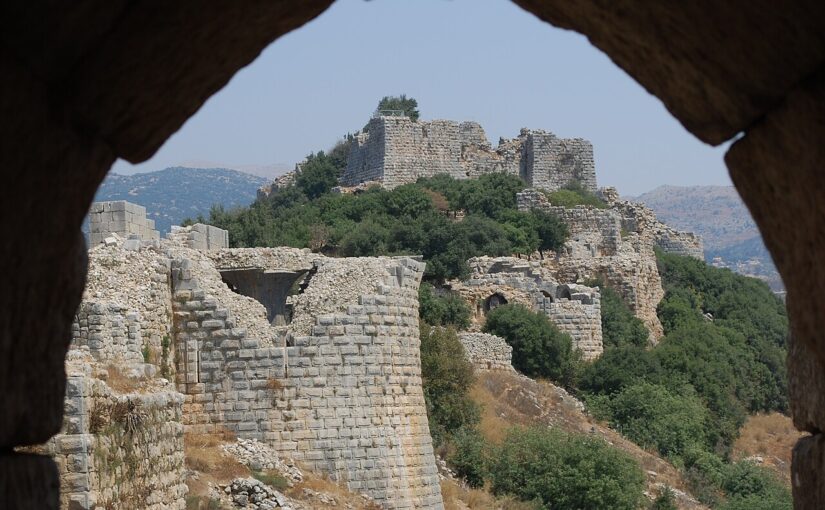In the far north of Israel, where green hills rise abruptly toward the heights of Mount Hermon, Nimrod Castle commands a breathtaking view of the Golan. The air here is fresh and cool, the mountains shrouded in mist on winter mornings, and the forests of Banias below shimmer with waterfalls and ancient oaks. Along the winding approach, the fortress seems to materialize out of legend—a line of walls, towers, and arched gateways etched against the sky. As visitors crest the ridge, stone ramparts stretch over the slopes, offering vistas that take in Lebanon, Syria, and the lush valleys of Galilee. Nature and myth entwine, giving Nimrod Castle a setting worthy of its centuries-old tale.
Origins and Key Figures
Nimrod Castle, known as Qala’at Nimrud or Kal’at al-Subeiba, traces its story through a tumultuous Middle Ages. Built in the early 13th century, it first arose under Al-Aziz Othman, the Ayyubid governor of Damascus and a nephew of Saladin. The castle’s purpose was clear—defend the vital road to Damascus from any advancing Crusader armies and affirm Muslim control of the region. Perched on its strategic ridge, the fortress was quickly and powerfully constructed with vaults, towers, and hidden passages. Its builders used massive square-cut stones, some echoing the grandeur of Herodian architecture in Jerusalem. Rapid expansion followed under the Mamluk Sultan Baybars, who reinforced the walls, carved inscriptions in the stone, and raised the castle to new heights of military sophistication.
Through the generations, Nimrod Castle became the stage for drama and shifting fortunes. The Crusaders coveted it, reportedly receiving it as part of a treaty in 1129, though Muslim forces quickly seized it back. Mongol invaders passed through in 1260, briefly claiming the fortress before surrendering it to the resurgent Mamluks. Baybars, the victorious sultan, rewarded his general Bilik by entrusting him with the castle, which saw further renovation and enhancement. These waves of conquest left their mark, layering the fortress with styles, inscriptions, and defensive improvements that remain visible to visitors today.
Military Role and Cultural Significance
Nimrod Castle was more than a stone relic. For centuries, it served as the bulwark against any army daring to approach Damascus from the west. Its walls overlook the main passage between Tyre and Damascus—a chokepoint for trade, soldiers, and the ambitions of distant empires. The castle’s towers, some still over thirty feet tall, provided sweeping sight-lines and a daunting presence against would-be attackers. Ingenious systems supplied water under siege, with reservoirs and protected staircases hidden away for emergencies.
Culturally, the fortress became an emblem of the region’s resilience. Arabic inscriptions carved by its Mamluk defenders echo with pride and poetry. Legends grew around the site, including the belief that Nimrod, the mighty hunter from Genesis, once ruled from its summit—even though medieval builders never sought his blessing. The castle’s mythic allure grew over time, drawing Druze and Arab communities who associated it with sacred places and ancient tales.
Exploring the Fortress Today
Visitors to Nimrod Castle step into a monument both majestic and mysterious. The route through the fortress unrolls like a story, from the northwest tower through echoing halls and chambers, to secret passages and the great central keep. Inscriptions from centuries ago line the stones. Arches frame the valley below, and the fortress reveals its ingenious layout with each bend in the walls. The southwest tower opens onto an indoor reservoir, a silent testimony to the fortitude of those who held out against siege.
Climbing to the highest points, explorers savor panoramic views—mountains cloaked in clouds, forests spread below, with the snowy peak of Mount Hermon in the distance. The shifting light brings alive the monumental architecture, while the wind sifts through stones that have witnessed the rise and fall of empires. From family picnics to history buffs searching for the Baybars Inscription, each visitor finds new ways to experience the scale and drama of Nimrod Castle.
Legacy and Why Visit
Today, Nimrod Castle stands as the largest medieval fortress in Israel and one of the best-preserved examples from the Crusader era in the region. Though time, earthquakes, and centuries of neglect wore at its defenses, restoration and archaeological research have resurrected its imposing silhouette for new generations. Nimrod Castle represents the fusion of myth and strategy—a place where Muslim dynasties, Crusaders, and Mongols all left their stories in stone.
To walk its ramparts is to step into a living chronicle. The site’s endurance through history makes it an essential destination for travelers who crave both natural beauty and the thrill of discovery. Its legends, panoramic views, and layered stories offer something rare and unforgettable. Nimrod Castle invites visitors to hike its walls, uncover its hidden chambers, and study its carved messages from the past. In the heart of the Golan Heights, it offers a journey into history and landscape, one that endures long after you leave its gates behind.
Image by Chadica from Jerusalem, Israel.
If our work has inspired you, helped you grow, or simply brought a little warmth to your day, consider supporting Thalysia.com with a small donation. Your contribution helps us continue exploring ancient landscapes, documenting local traditions, and celebrating the art of living well.
